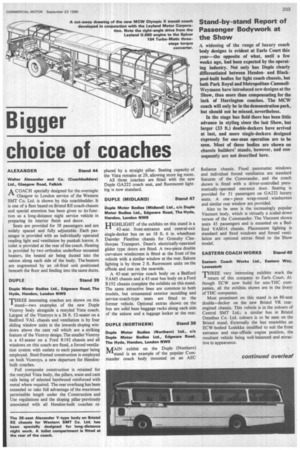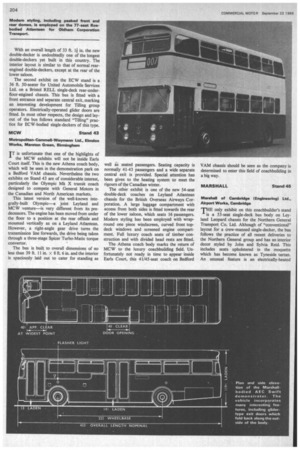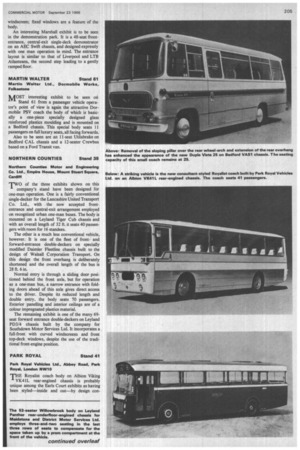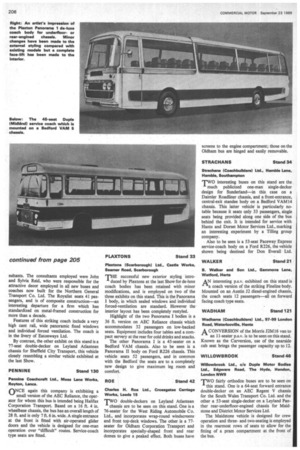Bigger choice of coaches
Page 229

Page 230

Page 231

Page 232

If you've noticed an error in this article please click here to report it so we can fix it.
ALEXANDER Stand 44 Walter Alexander and Co. (Coachbuilders) Ltd., Glasgow Road, Falkirk
A COACH specially designed for the overnight
Glasgow to London service of the Western SMT Co. Ltd. is shown by this coachbuilder. It is one of a fleet based on Bristol RE coach chassis and special attention has been given to its function as a long-distance night service vehicle in preparing its interior finish and decor.
Seats are provided for 38 passengers and are widely spaced and fully adjustable. Each passenger is provided with an individually operated reading light and ventilation by punkah louvre. A toilet is provided at the rear of the coach. Heating is provided by two orthodox underfloor mounted heaters, the heated air being ducted into the saloon along each side of the body. The heaters are augmented by an oil-fired unit positioned beneath the floor and feeding into the same ducts.
DUPLE Stand 39 Duple Motor Bodies Ltd., Edgware Road, The Hyde, Hendon, London NW9
THREE interesting coaches are shown on this stand—two examples of the new Duple Viceroy body alongside a restyled Vista coach. Largest of the Viceroys is a 36 ft. 52-seater on a Bedford VAL chassis and ventilation is by four sliding window units in the inwards sloping windows above the cant rail which are a striking feature of the Viceroy design. The smaller Viceroy is a 45-seater on a Ford R192 chassis and all windows on this coach. are fixed, a forced ventilation system with outlets to each passenger being employed. Steel-framed construction is employed on both Viceroys, a new departure for Hendonbuilt coaches.
Full composite construction is retained for the restyled Vista body, the pillars, waist and cant rails being of selected hardwood reinforced with metal where required. The rear overhang has been extended to take full advantage of the maximum permissible length under the Construction and Use regulations and the sloping pillar previously associated with all Hendon-built coaches re placed by a straight pillar. Seating capacity of the Vista remains at 29, allowing more leg room.
All three coaches are fitted with the new Duple 0A222 coach seat, and fluorescent lighting is now standard.
DUPLE (MIDLAND) Stand 47
Duple Motor Bodies (Midland) Ltd., Wo Duple Motor Bodies Ltd., Edgware Road, The Hyde, Hendon, London NW9
HIGHLIGHT of the exhibits on this stand is a 42-seat front-entrance and central-exit single-decker bus on an 18 ft. 6 in. wheelbase Daimler Fleetline chassis for Grimsby Cleethorpes Transport. Dean's electrically-operated glider type doors are fitted. A two-piece double curvature windscreen is fitted at the front of the vehicle with a similar window at the rear. Saloon lighting is by three 2 ft. fluorescent units on the offside and one on the nearside.
A 45-seat service coach body on a Bedford YAMS chassis and a 45-seat bus body on a Ford R192 chassis complete the exhibits on this stand. The same attractive lines are common to both models, but ornamental exterior moulding and service-coach-type seats are fitted to the former vehicle. Optional extras shown on the bus are solid base baggage racks along each side of the saloon and a luggage locker at the rear.
DUPLE (NORTHERN) Stand 38
Duple Motor Bodies (Northern) Ltd., c/o Duple Motor Bodies Ltd., Edgware Road, The Hyde, Hendon, London NW9 MAIN exhibit on the Duple (Northern) 'stand is an example of the popular Commander coach body mounted on an AEC
Stand-by-stand Report of Passenger Bodywork at the Show
A widening of the range of luxury coach body designs is evident at Earls Court this year—the opposite of what, until a few weeks ago, had been expected by the operating industry. Not only has Duple clearly differentiated between Hendonand Blackpool-built bodies for light coach chassis, but both Park Royal and Metropolitan-CammellWeymann have introduced new designs at the Show, thus more than compensating for the lack of Harrington coaches. The MCW coach will only be in the demonstration park, but should not be missed, nevertheless.
In the stage bus field there has been little advance in styling since the last Show, but larger (33 ft.) double-deckers have arrived at last, and more single-deckers designed expressly for one-man operation are to be seen. Most of these bodies are shown on chassis builders' stands, however, and consequently are not described here.
Reliance chassis. Fixed panoramic windows and individual forced ventilation are standard features of the Commander, and the coach shown is fitted with a driver-controlled pneumatically-operated entrance door. Seating is provided for 51 passengers on GA222 luxury seats. A one piece wrap-round windscreen and similar rear window are provided.
Also to be seen is the increasingly popular Viscount body, which is virtually a scaled-down verson of the Commander. The Viscount shown seats 45 passengers and is mounted on a Bedford VAM14 chassis. Fluorescent lighting is standard and fixed windows and forced ventilation are optional extras fitted to the Show model.
EASTERN COACH WORKS Stand 40
Eastern Coach Works Ltd., Eastern Way, Lowestoft
THREE very interesting exhibits mark the return of this company to Earls Court. Although ECW now build for non-THC companies, all the exhibits shown are in the livery of THC companies.
Most prominent on this stand is an 80-seat double-decker on the new Bristol VR rearengined chassis. This vehicle is in the colours of Central SMT Ltd.; a similar bus in Bristol Omnibus Co. Ltd. colours is to be seen on the Bristol stand. Externally the bus resembles an ECW-bodied Lodekka modified to suit the front entrance and rear-offside engine position, the resultant vehicle being well-balanced and attractive in appearance.
Modem styling, including peaked front and rear domes, is employed on the 77-seat Roebodied Atlantean for Oldham Corporation Transport.
With an overall length of 33 ft. 1 in. the new double-decker is undoubtedly one of the longest double-deckers yet built in this country. The interior layout is similar to that of normal rearengined double-deckers, except at the rear of the lower saloon.
The second exhibit on the ECW stand is a 36 ft. 50-seater for United Automobile Services Ltd. on a Bristol RELL single-deck rear-underfloor-engined chassis. This bus is fitted with a front entrance and separate central exit, marking an interesting development for Tilling group operators. Electrically-operated glider doors are fitted. In most other respects, the design and layout of the bus follows standard "Tilling" practice for ECW-bodied single-deckers of this type.
MCW Stand 43
Metropolitan-Cammell-Weymann Ltd., Elmdon Works, Marston Green, Birmingham
TT is unfortunate that one of the highlights of
the MCW exhibits will not be inside Earls Court itself. This is the new Athena coach body, which will be seen in the demonstration park on a Bedford YAM chassis. Nevertheless the two exhibits on Stand 43 are of considerable interest, particularly the Olympic Mk X transit coach designed to compete with General Motors in the Canadian and North American markets.
This latest version of the well-known integrally-built Olympic—a joint Leyland and MCW venture—is very different from its predecessors. The engine has been moved from under the floor to a position at the rear offside and mounted vertically as on a Leyland Atlantean. However, a right-angle gear drive turns the transmission line forwards, the drive being taken through a three-stage Spicer Turbo-Matic torque convertor.
The bus is built to overall dimensions of no less than 39 ft. 11 in x 8 ft. 6 in. and the interior is spaciously laid out to cater for standing as well is seated passengers. Seating capacity is normally 41-43 passengers and a wide separate central exit is provided. Special attention has been given to the heating system to meet the rigours of the Canadian winter.
The other exhibit is one of the new 54-seat double-deck coaches on Leyland Atlantean Chassis for the British Overseas Airways Corporation. A large luggage compartment with access from both sides is fitted towards the rear of the lower saloon, which seats 16 passengers. Modern styling has been employed with wrapround one piece windscreen, curved front topdeck windows and screened engine compartment. Full luxury coach seats of timber construction and with divided head rests are fitted.
The Athena coach body marks the return of MCW to the luxury coachbuilding field. Unfortunately not ready in time to appear inside Earls Court, this 41/45-seat coach on Bedford VAM chassis should be seen as the company is determined to enter this field of coach building in a big way.
MARSHALL Stand 45
Marshall of Cambridge (Engineering) Ltd., Airport Works, Cambridge
E only exhibit on this coachbuilder's stand is a 53-seat single-deck bus body on Leyland Leopard chassis for the Northern General Transport Co. Ltd. Although of "conventional" layout for a crew-manned single-decker, the bus follows the practice of all recent deliveries to the Northern General group and has an interior decor styled by John and Sylvia Reid. This includes seats upholstered in the moquette which has become known as Tyneside tartan. An unusual feature is an electrically-heated windscreen; fixed windows are a feature of the body.
An interesting Marshall exhibit is to be seen in the demonstration park. It is a 48-seat frontentrance, central-exit single-deck demonstrator on an AEC Swift chassis, and designed expressly with one man operation in mind. The entrance layout is similar to that of Liverpool and LTB Atianteans, the second step leading to a gently ramped floor.
MARTIN WALTER Stand 61
Martin Walter Ltd., Dormobile Works, Folkestone
MOST interesting exhibit to be seen on Stand 61 from a passenger vehicle operator's point or view is again the attractive Dormobile FSV coach the body of which is basically a one-piece specially designed glass reinforced plastics moulding and is mounted on a Bedford chassis. This special body seats 11 passengers on full luxury seats, all facing forwards. Also to be seen are an 11-seat Utilabrake on Bedford CAL chassis and a 12-seater Crewbus based on a Ford Transit van.
NORTHERN COUNTIES Stand 35
Northern Counties Motor and Engineering Co. Ltd., Empire House, Mount Stuart Square, Cardiff
TWO of the three exhibits shown on this
company's stand have been designed for one-man operation. One is a fairly conventional single-decker for the Lancashire United Transport Co. Ltd., with the now accepted frontentrance and central-exit arrangement employed on recognized urban one-man buses. The body is mounted on a Leyland Tiger Cub chassis and with an overall length of 32 ft. it seats 40 passengers with room for 16 standees.
The other is a much less conventional vehicle, however. It is one of the fleet of frontand forward-entrance double-deckers on specially modified Daimler Fleetline chassis built to the design of Walsall Corporation Transport. On this design the front overhang is deliberately shortened and the overall length of the bus is 28 ft. 6 in.
Normal entry is through a sliding door positioned behind the front axle, but for operation as a one-man bus, a narrow entrance with folding doors ahead of this axle gives direct access to the driver. Despite its reduced length and double entry, the body seats 70 passengers. Exterior panelling and interior ceilings are of a colour impregnated plastics material.
The remaining exhibit is one of the many 69seat forward entrance double-deckers on Leyland P133/4 chassis built by the company for Southdown Motor Services Ltd. It incorporates a full-front with curved windscreens and front top-deck windows, despite the use of the traditional front-engine position.
PARK ROYAL Stand 41
Park Royal Vehicles Ltd., Abbey Road, Park Royal, London NW10
THE Royalist coach body on Albion Viking VIC4 IL rear-engined chassis is probably unique among the Earls Court exhibits as having been styled—inside and out—by design con
The 53-seater Willowbrook body on Leyland Panther rear-underfloor-engined chassis for Maidstone and District Motor Services Ltd. employs three-and-two seating in the last three rows of seata to compensate for the space taken up by a pram compartment at the front of the vehicle.
sultants. The consultants employed were John and Sylvia Reid, who were responsible for the attractive decor employed in all new buses and coaches now built for the Northern General Transport Co. Ltd. The Royalist seats 41 passengers, and is of composite construction—an interesting departure for a firm which has standardized on metal-framed construction for more than a decade.
Features of this striking coach include a very high cant rail, wide panoramic fixed windows and individual forced ventilation. The coach is in the livery of Eatonways Ltd.
By contrast, the other exhibit on this stand is a 77-seat double-decker on Leyland Atlantean chassis for Sheffield City Transport, this vehicle closely resembling a similar vehicle exhibited at the last Show.
PENNINE Stand 130
Pennine Coachcraft Ltd., Moss Lane Works. Royton, Lancs.
ONCE again this company is exhibiting a small version of the AEC Reliance, the operator for whom this bus is intended being Halifax Corporation Transport. Based on a 16 ft. 4 in. wheelbase chassis, the bus has an overall length of 28 ft. and is only 7 ft. 6 in. wide. A single entrance at the front is fitted with air-operated glider doors and the vehicle is designed for one-man operation over "difficult" routes. Service-coach type seats are fitted.
P LAXTO N S Stand 33
Plaxtens iScarboroughi Ltd., Castle Works, Sommer Road, Scarborough
THE successful new exterior styling intro
duced by Plaxtons at the last Show for de-luxe coach bodies has been retained with minor modifications, and is employed on two of the three exhibits on this stand. This is the Panorama I body, in which sealed windows aid individual forced-ventilation are standard. However the interior layout has been completely restyled.
Highlight of the two Panorama I bodies is a 36 ft. version on AEC Reliance chassis which accommodates 32 passengers on low-backed seats. Equipment includes four tables and a compact servery at the rear for cold drinks and snacks.
The other Panorama I is a 45-seater on a Bedford YAM chassis. Also to be seen is a Panorama II body on Ford R226 chassis. This vehicle seats 52 passengers, and in common with the Bedford the seats are to a completely new design to give maximum leg room and comfort.
ROE Stand 42
Charles H. Roe Ltd., Crosagates Carriage Works, Leeds 16
TWO double-deckers on Leyland Atlantean
chassis are to be seen on this stand. One is a 76-seater for the West Riding Automobile Co. Ltd., and incorporates wrap-round windscreens and front top-deck windows. The other is a 77seater for Oldham Corporation Transport and incorporates specially-shaped front and rear domes to give a peaked effect. Both buses have screens to the engine compartment; those on the Oldham bus are hinged and easily removable.
STRACHANS Stand 34
Strachana (Coachbuilders) Ltd., Horrible Lane, Hamble, Southampton
TWO interesting buses on this stand are the much publicized one-man single-decker design for Sunderland—in this case on a Daimler Roaciliner chassis, and a front-entrance, central-exit standee body on a Bedford VAM14 chassis. This latter vehicle is particularly notable because it seats only 33 passengers, single seats being provided along one side of the bus behind the exit. It is intended for service with Hants and Dorset Motor Services Ltd., marking an interesting experiment by a Tilling group company.
Also to be seen is a 53-seat Paceway Express service-coach body on a Ford R226, the vehicle shown being destined for Don Everall Ltd.
WALKER Stand 21
B. Walker and Son Ltd., Gammons Lane, Watford, Hens AN interesting p.s.v. exhibited on this stand is 4-4-a coach version of the striking Fineline body. Mounted on an Austin J2 diesel-engined chassis, the coach seats 12 passengers—all on forward facing coach type seats.
WADHAM Stand 121
Wadharns (Coachbuilders) Ltd., 97-99 London Road, Watertooville, Hants
A CONVERSION of the Morris J2M16 van to an 11-seater p.s.v. is to be seen on this stand. Known as the Carversion, use of the nearside cab seat brings the passenger capacity up to 12.
WILLOWBROOK Stand 46
Willowbrook Ltd., c/o Duple Motor Bodies Ltd., Edgware Road, The Hyde, Hendon, London NW9
TWO fairly orthodox buses are to be seen on -4this stand. One is a 64-seat forward entrance double-decker on an AEC Regent V chassis for the South Wales Transport Co. Ltdi and the other a 53-seat single-decker on a Leyland Panther rear-underfloor-engined chassis for Maidstone and District Motor Services Ltd.
The Maidstone vehicle is designed for crew operation and threeand two-seating is employed in the rearmost rows of seats to allow for the fitting of a pram compartment at the front of the bus.








































































































































































































































































































































































